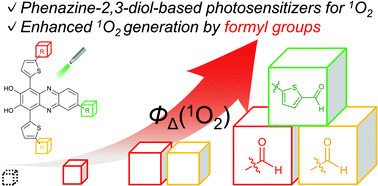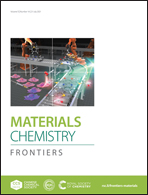Development of phenazine-2,3-diol-based photosensitizers: effect of formyl groups on singlet oxygen generation†
Abstract
Phenazine-2,3-diol derivatives KO-0–3, which have zero to three formyl groups, respectively, have been developed as photosensitizers (PSs) possessing the ability to generate singlet oxygen (1O2). The photoabsorption bands of KO-0–3 are significantly red-shifted compared to those of phenazine-2,3-MOM (methoxymethyl) derivatives 5–8, whose hydroxy and formyl groups are protected, and have onsets at around 600–650 nm. Furthermore, the fluorescence quantum yields (Φfl) of KO-0–3 (Φfl = 0.024–0.097) are lower than those of 5–8 (Φfl = 0.34–0.46) in solution. To gain insight into the 1O2 generation properties of KO-0–3, we evaluated the 1O2 quantum yields (ΦΔ) and rate constants (kobs), and demonstrated that KO-1–3 possess a higher ability to generate 1O2 under visible light irradiation than those of 5–8. Moreover, it was found that the ΦΔ values of KO-0–3 increase in the order of KO-0 (0.036) < KO-1 (0.22) < KO-2 (0.33) < KO-3 (0.41) with increasing number of formyl groups. This result indicates that formyl groups facilitate the intersystem crossing (ISC) from the lowest singlet excited states of the PSs (S1) to the triplet excited states (Tn) according to El-Sayed's rule. Consequently, this work provides useful knowledge in molecular design of efficient phenazine-2,3-diol-based PSs for photodynamic therapy (PDT).



 Please wait while we load your content...
Please wait while we load your content...